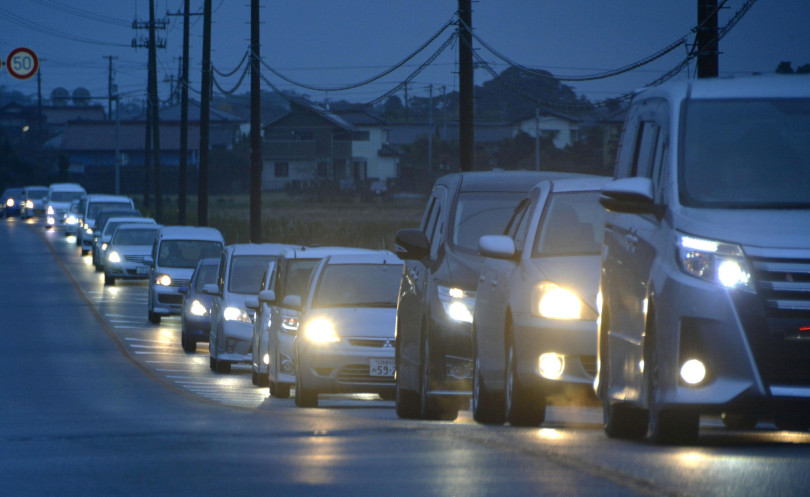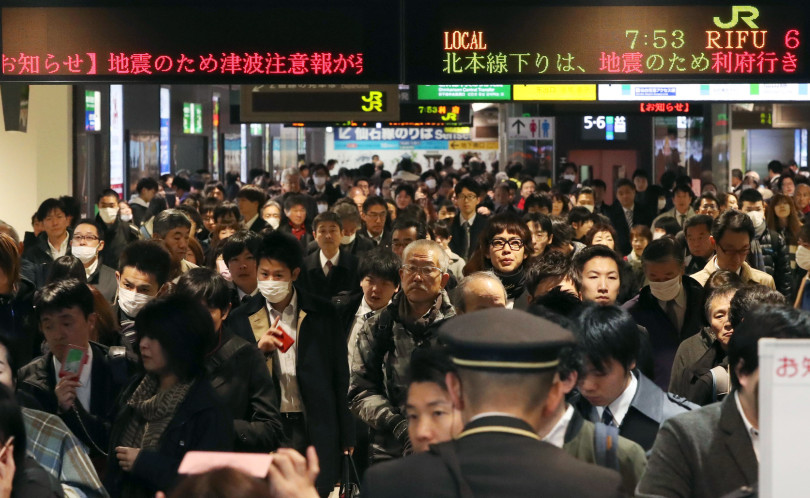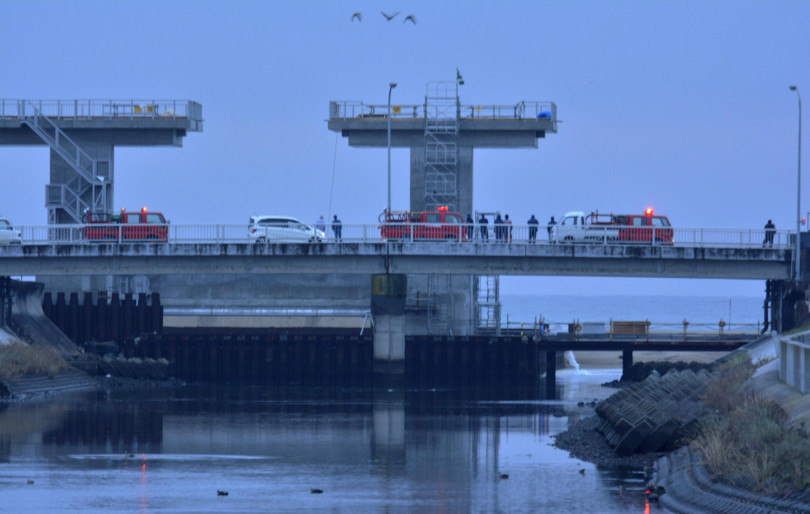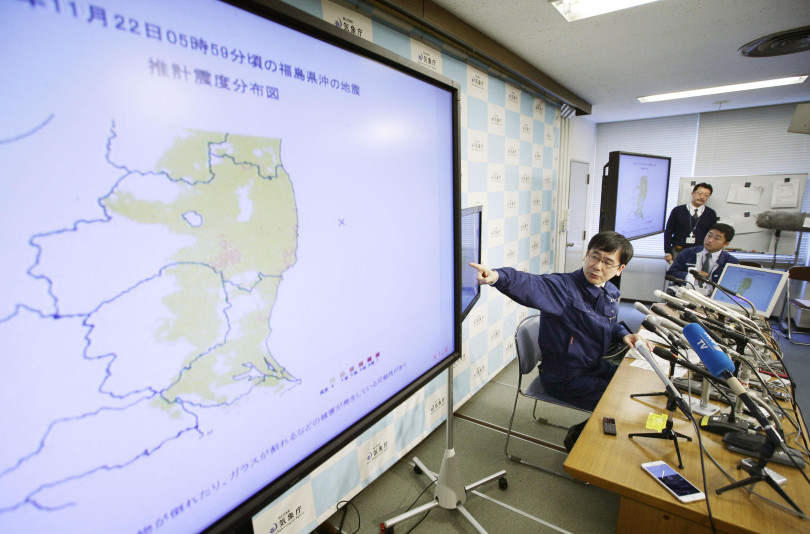
Vehicles make a line as they flee following a tsunami warning in Iwaki, Fukushima prefecture early Tuesday, Nov. 22, 2016. Coastal residents in Japan were ordered to flee to higher ground on Tuesday after a strong earthquake struck off the coast of Fukushima prefecture.
Passengers crowd at Sendai Station in Sendai, Miyagi prefecture, northern Japan Tuesday, Nov. 22, 2016 after train services are suspended following an earthquake. Coastal residents in Japan were ordered to flee to higher ground on Tuesday after a strong earthquake struck off the coast of Fukushima prefecture.
Firefighters and city officials check the water level at an estuary following a tsunami warning in Iwaki, Fukushima prefecture, early Tuesday, Nov. 22, 2016. Coastal residents in Japan were ordered to flee to higher ground on Tuesday after a strong earthquake struck off the coast of Fukushima prefecture.
Japan Meteorological Agency earthquake expert Koji Nakamura points a map of Fukushima and its surrounding prefectures during a press conference in Tokyo on a strong earthquake with a magnitude of 7.4 that struck off the coast of Fukushima Tuesday, Nov. 22, 2016. Coastal residents in Japan were ordered to flee to higher ground after the quake. The agency issued a tsunami warning for waves of up to 3 meters (10 feet) in Fukushima, north of Tokyo, which is home to the nuclear power plant that was destroyed by a huge tsunami following an offshore earthquake in 2011. There were no immediate reports of damage or injury. 
Firefighters and others watch the port to check the water level as a tsunami warning is issued following an earthquake in Soma, Fukushima prefecture, northern Japan, Tuesday, Nov. 22, 2016. Coastal residents in Japan were ordered to flee to higher ground on Tuesday after a strong earthquake struck off the coast of Fukushima prefecture.
TOKYO (AP) — The Latest on the earthquake that struck off the coast of Japan (all times local):
10:30 a.m.
A powerful earthquake off Japan has brought back memories of the 2011 tsunami and nuclear disaster.
Kazuhiro Onuki (kah-zoo-hee-roh oh-noo-kee) is a former librarian in a town that became a no-go zone because of radiation contamination. He was staying at what he calls one of his temporary homes when Tuesday’s magnitude 7.4 earthquake struck.
He says he remembered “3.11,” a reference to the March 11 date of the 2011 disaster.
He adds: “It really came back. And it was so awful. The sways to the side were huge. But nothing fell from shelves.”
Onuki was alone when the latest earthquake struck and worries it could be a warning of things to come.
Elsewhere, a board of education worker rushed to work after the earthquake to make sure everyone was responding to the evacuation warnings.
Daisuke Kida (die-soo-keh kee-dah) said the residents are all well-rehearsed on disaster drills after the 2011 tsunami.
___
9:45 a.m.
Japan has lifted a tsunami warning for its northeastern coast nearly four hours after a powerful offshore earthquake.
A tsunami advisory for waves of up to 1 meter (3 feet) remains in place for much of the Pacific coast.
The earlier warning was for waves of up to 3 meters (10 feet). The Japan Meteorological Agency had urged residents to flee quickly to higher ground.
The largest wave recorded was 1.4 meters (4.6 feet) at Sendai Bay.
___
9:30 a.m.
Tsunami waves of up to 1.4 meters (4.6 feet) have hit the Japanese coast after a magnitude-7.4 earthquake struck offshore Tuesday morning.
A tsunami warning remains in effect for Fukushima and Miyagi prefectures on the Pacific in northeast Japan. The same region was struck by a devastating tsunami in 2011.
The highest tsunami so far was recorded at Sendai Bay about two hours after the earthquake. The Japan Meteorological Agency has recorded smaller waves along the coast. It warned that waves of up to 3 meters (10 feet) could reach Fukushima and Miyagi prefectures.
___
9 a.m.
A utility official says he believes that a cooling water pump that stopped working at a Japanese nuclear power plant after a strong earthquake was shut off automatically by a safety system as the water in the pool shook.
The utility says that a backup pump was launched to restore cooling water to spent fuel storage pool at the No. 3 reactor of the Fukushima Dai-ni plant.
The plant is close to the Fukushima Dai-ichi plant that went into meltdown in 2011 after a tsunami swamped the plant, knocking out power to the cooling systems. Both plants are operated by Tokyo-based TEPCO.
A magnitude 7.4 earthquake struck off Fukushima prefecture on Tuesday morning, sending tsunami waves toward the Japanese coast. So far, no major damage has been reported.
Naohiro Masuda, head of TEPCO’s decommissioning unit, said decommissioning work at the destroyed Fukushima Dai-ichi plant has been temporarily suspended because of the earthquake.
___
7:30 a.m.
Long lines of cars, with their headlights on, are formed as coastal residents follow government orders to flee to higher ground after a strong earthquake with a magnitude of 7.4 struck off the coast of Fukushima prefecture.
The Japan Meteorological Agency issued a tsunami warning for waves of up to 3 meters (10 feet) in Fukushima, which is home to the nuclear power plant that was destroyed by a huge tsunami following an offshore earthquake in 2011. There were no immediate reports of damage or injury.
Contacts:Manager Gao
Sale dept:
Mob: +86-15932423630
Tel: +86-311-89276065
Email: sales@ht-wiremesh.com
Production Dept:
Tel: +86-318-8063366
Email: 32409058@qq.com
Quality control dept:
Tel: +86-318-8063399
Email: michellegao118@hotmail.com
Complaints dept:
Tel: +86-15932423630
Email: mesh@ht-wiremesh.com
Address:Wire Mesh Zone,Anping County,Hebei Province,China.
